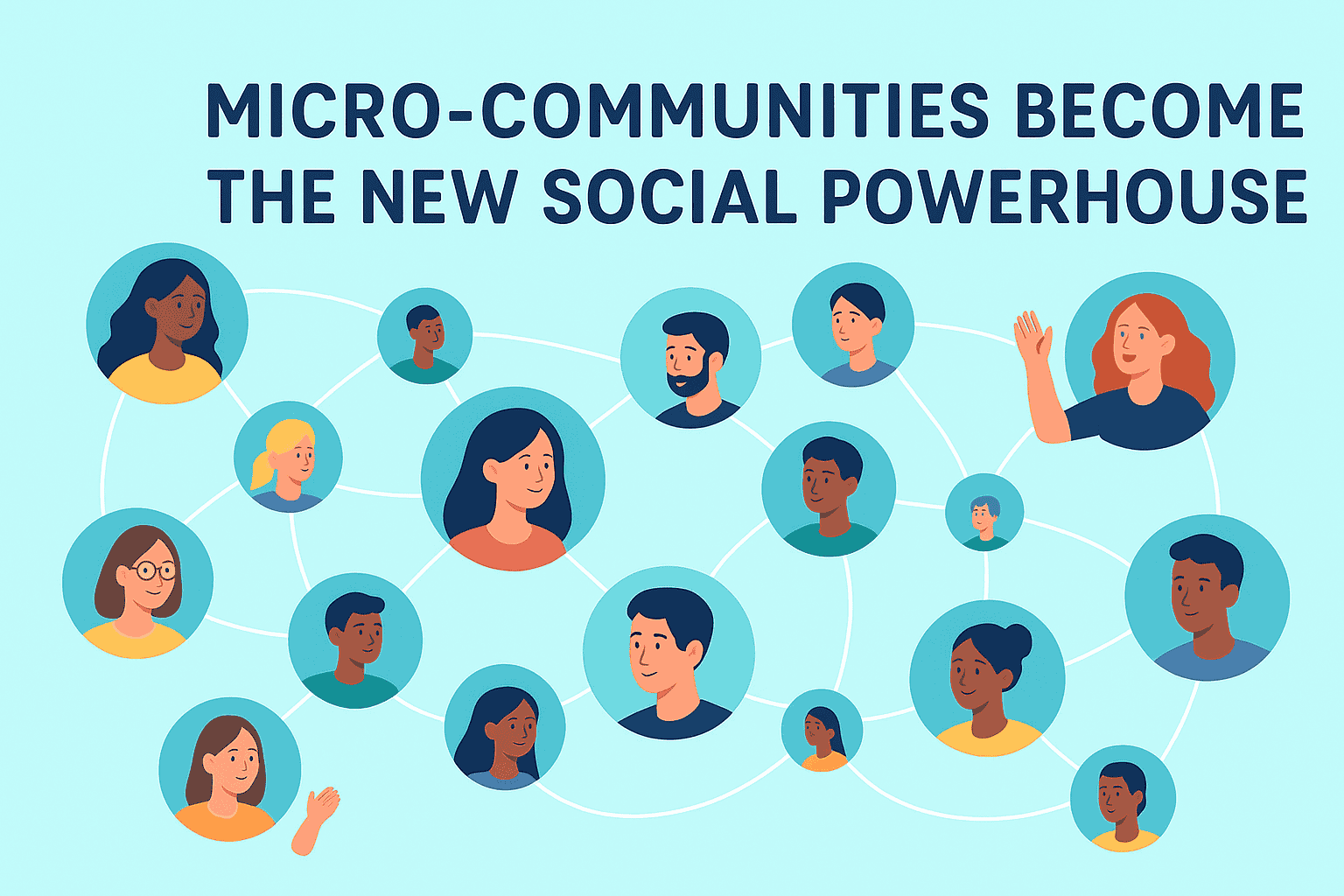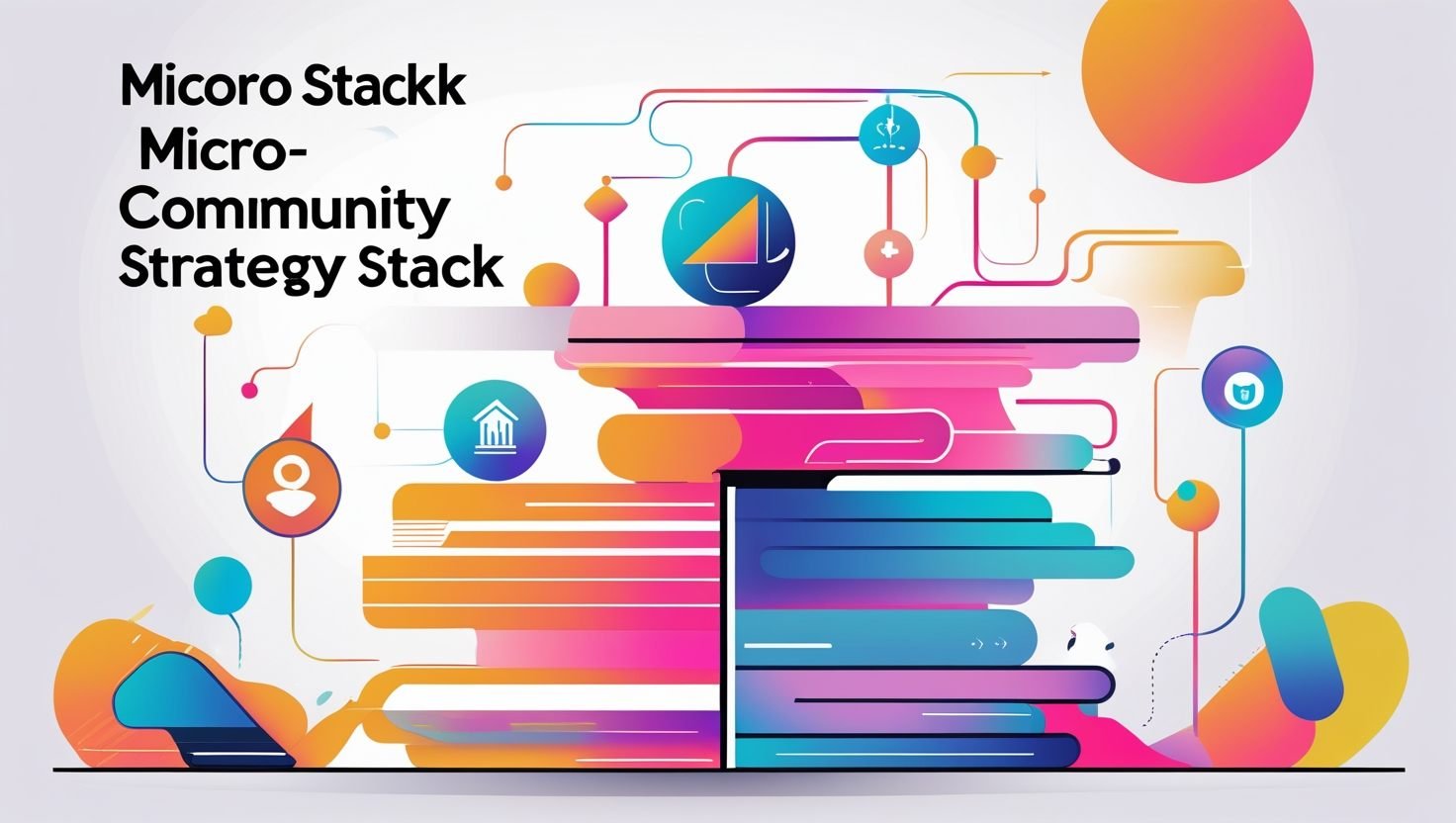Introduction
 digital landscape, size isn’t everything. While massive social media platforms and sprawling online audiences once defined influence, a new trend is quietly reshaping the rules: Micro-Communities. These small, tightly knit groups—often built around shared interests, values, or goals—are proving to be far more engaged, loyal, and impactful than traditional mass audiences. From niche hobbyists to brand enthusiasts, Micro-Communities are becoming the engines of authentic connection, peer-to-peer influence, and even market power.
digital landscape, size isn’t everything. While massive social media platforms and sprawling online audiences once defined influence, a new trend is quietly reshaping the rules: Micro-Communities. These small, tightly knit groups—often built around shared interests, values, or goals—are proving to be far more engaged, loyal, and impactful than traditional mass audiences. From niche hobbyists to brand enthusiasts, Micro-Communities are becoming the engines of authentic connection, peer-to-peer influence, and even market power.
As brands, creators, and organizations navigate this shift, understanding the rise of Micro-Communities isn’t just optional—it’s essential. In this article, we’ll explore how these small yet mighty groups are becoming the new social powerhouses and why their influence often outweighs sheer numbers.
Why “Micro-Communities” matter now
Feeds have splintered, attention is scarce, and trust has shifted from big broadcasts to small rooms. People now congregate in purpose-led spaces—Discord servers, Sub stack chats, WhatsApp circles, niche forums—where peers feel closer and conversations run deeper. Trust data backs the behavior: Edelman’s 2024 Trust Barometer shows peers are trusted roughly on par with experts for truth about innovation, explaining why guidance inside tight groups disproportionately moves decisions. Meanwhile, platforms themselves are tilting toward niche scale: Discord and Sub stack publicly champion smaller, high-intent communities over “go-viral” dynamics, reinforcing the idea that Micro – communities become the new social powerhouses for influence and conversion. For brands, this re-centers strategy from rented reach to owned relationships.
The engagement vs. reach trade-off for brands
For marketers, micro beats macro when outcomes hinge on depth: richer comments, faster feedback loops, and warmer referrals from members who already share context. The reach you surrender is often offset by intent. Surveys in 2025 show brands report the most success with micro and nano creators, and routinely set benchmarks like 3%+ engagement on Instagram and double-digit rates on TikTok for smaller creators—levels mega accounts rarely. In practical terms, this reshapes channel mix and measurement: prioritize spaces where members co-create (Discord, private groups, forums), invest in credible hosts, and use tools that surface member questions and product insights.
The trade-off is real. Micro spaces cap scale and require patience, governance, and hands-on facilitation. Content must be participatory, not performative; reporting must shift from vanity reach to “quality time spent,” resolution rates, member-led ideas shipped, and LTV movement. But when a brand consistently shows up, Micro – communities become the new social powerhouses because compounding trust amplifies every action: a single helpful thread spawns user guides, a small beta channel hardens roadmaps, and a niche meetup turns into a dependable sales engine.
A pragmatic playbook: segment superfans by use case or locale; stand up lightweight spaces where they already congregate; empower credible hosts; instrument feedback loops; and reward pro-social behaviors. Measure leading indicators weekly—active members, replies per post, first-response time—then link them to lagging outcomes like retention, referral, and CAC payback. In short, trade rented reach for owned relationships; depth will scale you, sustainably.
What Exactly Is a Micro-Community?
Definition, Size Bands, and Traits (niche interest, shared rituals, peer-to-peer dynamics)
A micro-community is a small, tightly knit group of individuals united by a specific interest or purpose—whether that’s a shared passion (like vegan cooking or clean beauty), a brand affinity, or a professional niche. It isn’t just a broad audience or follower base—it’s a committed cohort fostering genuine dialogue, knowledge exchange, and co-creation.
Size Bands:
- Typically small and manageable: around 30 dedicated members, where rapport and personalization thrive.
- Brands with more capacity may house hundreds to low-thousands, yet even then, these spaces maintain intimacy and high-value interaction.
Core Traits:
- Niche interest: Every participant shares a finely tuned focus—say, vegan beauty or a micro-vertical hobby—making discourse purposeful.
- Shared rituals: Recurring patterns—weekly Q&As, themed prompts, UGC sharing rituals—forge deeper cohesion and identity. Though less explicitly noted in sources, these rituals are the connective tissue nurturing trust and belonging.
- Peer-to-peer dynamics: Unlike monologue broadcasts, Micro-Communities thrive on two-way, often peer-driven dialogue. Members support, advise, and build together—a hallmark of trust, co-creation, and ownership.
In essence, when Micro – communities become the new social powerhouses, it’s these rich, targeted, trust-based spaces—far more than sprawling audiences—that fuel authentic influence.
How Micro-Communities Differ from Audiences, Followers, and Forums
Though they all live under the broader banner of online engagement, Micro-Communities, audiences, followers, and forums are fundamentally different:
| Group Type | Size & Scope | Interaction Style | Relationship Nature |
| Audience / Followers | Typically large—tens of thousands to millions | Mainly one-way (broadcast) | Transactional; passive consumption |
| Micro-Community | Small (tens to low-thousands) | Highly interactive, peer-driven | Two-way, reciprocal, trust-rich |
| Forum | Potentially large, open-ended | Threaded discussion; often one-to-many | Looser ties; may lack shared intent or ritual |
Audiences/Followers: Large, broad, and often passive. The brand or creator speaks; audiences consume, occasionally react. Engagement tends to be shallow—likes, comments, buys—but lacks accountability or sustained interaction.
Micro-Communities: Intimate, participatory, and relational. They are instead two-way ecosystems, where ideas flow among peers, trust builds fast, and feedback loops are tight. This dynamic elevates them; when Micro – communities become the new social powerhouses, it’s because they deliver quality over quantity.
Forums: Public, topic-based discussion boards with many users and threads. While forums can still foster conversation, they lack the curated intimacy—a micro-community’s element of shared ritual and exclusivity is often missing
Where Micro-Communities Live (Platform Landscape)

Reddit: Topic Subreddits, AMA Culture, and Search Visibility
Reddit is structured around subreddits, which are focused, user-created communities—such as r/science (with over 33 million members) or r/Accredit (around 50 million members)—where topic-specific discussions unfold. These spaces embody how Micro-Communities become the new social powerhouses, enabling concentrated engagement and niche exploration.
The AMA (Ask Me Anything) format, especially through r/Ima, allows experts or well-known figures to interact directly with users in a candid Q&A style. This fosters real-time, dynamic engagement driven by curiosity and transparency.
Moreover, Reddit’s content frequently ranks high in search results—particularly for product reviews and how-to content—enhancing visibility and connecting micro-community discourse with broader search-driven audiences .
Discord: Always-On Servers, Roles, and Real-Time Voice/Text
Discord offers persistent “servers”, virtual spaces that exist continuously. Users return to familiar channels—text, voice, or video—creating a dynamic yet stable environment. It feels like “a party that never stops,” where conversation flows effortlessly.
Customization is key: communities use roles and permissions to structure access, facilitate moderation, and enhance member involvement—turning simple icons or colors into meaningful designations like “moderator,” “VIP,” or “new member”.
Discord also supports real-time communication through voice and chat (text, video, and screen-sharing) as well as structured forums, threads, and media channels, enabling both spontaneous and organized interaction.
This design—constant accessibility, customization, and real-time exchange—makes Discord a vivid example of how Micro-Communities become the new social powerhouses, thriving on intimacy and immediacy.
WhatsApp / Telegram: Private Groups, Broadcasts, and Local Clusters
Telegram allows communities to form massive, private or public groups hosting up to 200,000 members, plus broadcast channels managed by admins. Features like threaded replies, bots, anonymity, and content protection (blocking screenshots or forwarding) enhance moderation and trust.
WhatsApp, while not detailed by our sources here, similarly offers private group chats, broadcast lists, and localized clusters, enabling hyper-geographic or interest-based Micro-Communities—often under the radar yet rich in personal connection.
Niche Platforms & Vertical Communities (Geneva, Strava Clubs, Fandom Spaces)
Beyond giants like Reddit and Discord, specialized platforms host interest-specific Micro-Communities:
- Strava clubs gather runners or cyclists around shared routes, goals, or local meetups; elite athletes exchange training tips in real time.
- Fandom spaces—forums built around book series, movies, or games—enable deep dives into lore, theories, and creative works.
- New platforms like Geneva (though less widely reported) are gaining traction as curated hubs for shared interests—from poetry circles to tech deep-dives.
These vertical communities, though smaller in scale, often boast higher engagement, trust, and conversion—where Micro-Communities become the new social powerhouses in niche verticals.
Owned Community Hubs (Discourse, Circle, In-Product Communities)
Brands and creators increasingly build owned hubs using platforms like Discourse, Circle, or embedded in-app communities—where they control branding, data, and governance. These hubs offer:
- Structured conversation through categories, threads, and tagging.
- Ownership of data and experience, free from algorithmic interference.
- Enhanced brand affinity and loyalty, as communities define their own norms and culture.
These ownable spaces are fertile ground for Micro-Communities to become the new social powerhouses, grounding engagement where brands can nurture relationships and long-term value.
The Business Case — What Micro Beats Macro On
Depth of Engagement: Time-Spent, Replies per Member, Repeat Touchpoints
Micro-Communities flourish on intimacy and interaction quality. Members return repeatedly, engaging deeply over time: sharing, replying, and building momentum. McKinsey describes this as part of a powerful community flywheel, where engaged members spark conversations, co-create content, and spread loyalty—accelerating both participation and impact. Unlike passive audiences, Micro-Communities sustain higher time-spent per member, richer reply threads, and frequent touchpoints, making “Micro – communities become the new social powerhouses” not by size but by intensity.
Better Unit Economics: Lower CAC via Referrals; Higher LTV via Retention
Micro-Communities are small, tightly knit groups united by specific interests or goals. They are not just large audiences or follower counts; they foster genuine dialogue, shared rituals, and peer-to-peer learning. Brands are increasingly noticing the power of these communities, as they allow for deeper engagement, better insights into customer preferences, and co-created content that feels authentic. The intimacy of Micro-Communities also means that members are more likely to trust recommendations, participate actively, and advocate for the brand organically, creating a multiplier effect that traditional marketing struggles to achieve.”
Qualitative Advantages: Faster Feedback Loops, Co-Creation, UGC Flywheels
Micro-Communities aren’t just economically efficient—they’re structurally agile. They enable rapid feedback loops; product teams can test ideas directly, users weigh in, and solutions iterate quickly. Growth-on omics highlights how support and innovation communities (e.g., Salesforce, PowerSchool) gather suggestions, resolve issues, and drive engagement organically. This feeds directly into UGC (User-Generated Content) flywheels: community members generate content—reviews, tutorials, case studies—that amplify brand presence at minimal cost. McKinsey’s “community flywheel” model underscores how authentic member dialogue fuels brand stories and engagement, accelerating growth through shared narratives. In these contexts, Micro – communities become the new social powerhouses, not by broadcasting at scale, but by harnessing member-driven creativity, input, and momentum
Micro-Community Strategy Stack
Positioning: Pick a Sharp Niche, Purpose, and Membership Promise
Effective Micro-Communities begin with razor-sharp positioning:
- Define a niche that’s specific, bound by shared passions, roles, or challenges—e.g., “early-stage startup founders in Bengaluru” rather than “entrepreneurs.” Clarity fosters relevance.
- Articulate a compelling purpose—a reason to join beyond passive consumption: collaboration, learning, mutual support, or early access.
- Craft a membership promise that answers: What will members gain if they stick around? For example: “Monthly peer-led product-growth deep dives” or “access to co-development cohorts.”
This precision in positioning ensures your micro-community resonates with intent. It’s no accident that Micro – communities become the new social powerhouses—they thrive on shared focus and creating value beyond scale, not by casting a wide net.
Governance: Codes of Conduct, Moderation Workflows, Safety & Privacy
Strong governance ensures your micro-community remains welcoming, safe, and vibrant:
- Codes of Conduct (CoC): Establish a clear and concise rulebook—typically 5–10 bullet points—that defines acceptable behavior, prohibited content, and tone ([turn0search1]). Link these prominently and include them in onboarding communications.
- Moderation workflows: Build structured workflows that include:
- Member reporting tools (anonymous where appropriate).
- Transparent investigation and consistent enforcement.
- Escalation protocols for serious issues (harassment, legal concerns) ([turn0search1], [turn0search0]).
- Periodic review of policies to adapt as your community evolves ([turn0search8]).
- Safety & privacy measures:
- Clearly communicate privacy practices and data usage.
- Limit access to sensitive channels or members.
- Provide reporting and blocking tools and educate members on using them ([turn0search4]).
- Transparency & trust: Share moderation summaries (e.g., “We removed X posts this week for guideline violations”) to build confidence in fair enforcement ([turn0search0]).
With governance clarity in place, your micro-community can become a safe space where Micro – communities become the new social powerhouses—grounded in trust.
Roles: Host/Facilitator, “Connectors,” SMEs, and Moderator Pods
A healthy micro-community relies on clearly assigned roles:
- Host / Facilitator: The neutral orchestrator—sets agendas, drives conversation, encourages participation, and ensures alignment ([turn0search13]). Think of the host as the conductor, guiding but not controlling.
- Connectors: Active members who bridge others, introduce newcomers, and strengthen social bonds across sub-groups.
- Subject Matter Experts (SMEs): Trusted voices who provide insight, training, or credibility on niche topics. Their participation elevates perceived value.
- Moderator Pods: A small team—ideally with different focus areas (e.g., content integrity, conflict arbitration, onboarding)—spread workload, manage escalation, and maintain consistency ([turn0search1], [turn0search3]).
- + Optional:
- Power Users / Community Architects: In some communities, long-standing contributors shape norms, workflows, or feature ideas ([turn0search14]).
- Support Roles: For emotional moderation, training new moderators, or analytics oversight.
When these roles are clear and active, your micro-community truly becomes a social powerhouse: distributed leadership among facilitators, connectors, SMEs, and moderators breeds resilience, richness, and authenticity—making Micro – communities become the new social powerhouses, not by central broadcast, but through shared stewardship.
Content That Works Inside Micro-Communities
Conversational Prompts and Recurring Threads (wins, builds, demos)
Recurring prompts and thematic threads serve as the lifeblood of Micro-Communities, anchoring both rhythm and engagement. Common formats include threads like “Show Your Wins,” “What Are You Building Today?”, or “Demo Drop,” which encourage members to share achievements, ongoing work, or creative experiments. These structured invitations:
- Spark habitual participation,
- Surface peer inspiration,
- Encourage “micro-celebrations” that amplify culture.
As noted in design frameworks for co-creative communities, such rituals—“weekly community jams,” structured ideation prompts, and build-with-us calls—encode purpose and trust into regular cadence and invite everyone into ongoing contribution.
When Micro – communities become the new social powerhouses, it’s often because these recurring conversational frameworks engage members regularly, turning sporadic activity into sustained momentum.
Utility Posts: Templates, Checklists, How-Toes, Mutual Aid
Utility-driven content resonates strongly in focused communities. Whether it’s a ready-made template, a practical checklist, a step-by-step how-to post, or a mutual aid thread where members ask for and share help—these posts offer immediate, tangible value. They foster a culture of reciprocal generosity and practical support.
This approach aligns with participatory design principles, where end users co-design solutions and contribute structured frameworks that become community norms—deepening involvement and reinforcing trust.
Moreover, content catalogs with checklists or guides help members solve real problems—making the community not just another feed, but a resource-rich hub where Micro – communities become the new social powerhouses because they consistently provide useful value, not just content.
Co-Creation Formats: Polls, Challenges, Build-in-Public
Co-creation elevates engagement by inviting members to co-author the community’s journey. Formats like:
- Polls (e.g., vote on next topic, choose event times),
- Challenges (e.g., “30-day writing sprint,” “weekend design challenge”),
- Build-in-public campaigns (members share progress, prototypes, feedback in real time),
transform the community from passive to participatory. As described in design research, communities optimized for co-creation embed tools like idea boards, feedback loops, challenges, and sprints into their structure—making contribution the default, not the exception. Platforms such as LEGO Ideas, Open IDEO, or Threadless exemplify this: community members submit concepts, vote, and help shape real-world outcomes.
These formats underscore why Micro – communities become the new social powerhouses—they don’t just share content; they build together, amplifying engagement, ownership, and innovation.
Measurement — Proving Value Without Vanity Metrics
Core Health Metrics: Activation, Weekly Participation, Contributor Ratio
Tracking the vital signs of your micro-community helps distinguish between active ecosystems and ghost towns. Core health metrics are your early warning system:
- Activation: The percentage of new joiners who take a meaningful first action—posting, reacting, or commenting.
- Weekly Participation (WAU): Measures consistent engagement rhythms—what share of members are active each week? Platforms often segment by WAU or DAU to reveal engagement health.
- Contributor Ratio: The proportion of members who post versus those who just lurk. A high ratio suggests depth, shared ownership, and purpose-driven activity.
Combining these gives you a health snapshot that’s more telling than member counts alone. After all, Micro – communities become the new social powerhouses not through raw volume, but through vibrant, repeat interactions and shared activation.
Outcome Metrics: Referrals, Trials, Expansion Revenue, Retention Lift
To prove business impact, tie community health to real outcomes:
- Referrals & Trials: Track how many new users or trial sign-ups come via community links, discussions, or projects.
- Expansion Revenue: Measure upsells or premium conversions among active community members. In SaaS, Net Revenue Retention (NRR)—which accounts for expansions minus churn within existing users—is a powerful indicator of upstream community impact.
- Retention Lift: Compare retention or churn rates between active community members versus non-members. Studies show engaged community users often stay longer and spend more.
- Support Cost Deflection: Measure how much support effort the community eliminates—community forums resolving help questions reduce support overhead significantly (e.g. 14% fewer support cases in Khor’s communities).
These outcome metrics help executives see that Micro – communities become the new social powerhouses, delivering business-aligned growth and operational efficiencies—not just friendly chit-chat.
Sentiment & Trust: Qualitative Tagging, NPS/ENPS, “Quality Time Spent”
Beyond numbers, perception underscores value. Measure sentiment and trust through:
- Qualitative Tagging: Flag valuable posts—like idea submissions, support feedback, or peer praise—to track sentiment trends over time.
- NPS / ENPS: Use Net Promoter Score surveys tailored for community (e.g., “How likely are you to recommend this community?” or “Would you refer a colleague?”) to quantify member satisfaction and affinity.
- “Quality Time Spent”: Go beyond minutes logged; track sessions that include multiple replies, threaded discussions, or co-creation events—those that signal high-value interactions rather than passive scrolling.
When such sentiment and trust indicators are strong, you often see greater retention, advocacy, and authentic behavior—underscoring how Micro – communities become the new social powerhouses, not by vanity stats, but by meaningful connection.
Playbooks by Objective
Product Discovery & Research Hub (Insights, Beta Groups, Roadmap Votes)
Micro-Communities serve as ideal launchpads for product insights and validation. To build this playbook:
- Insight gathering via community feedback: Tap members to share pain points, emerging needs, and use-case nuance—turning qualitative insight into actionable direction.
- Beta groups: Invite a select set of micro-community members to early builds, closed-beta tests, or pilot features. Their focused, invested participation yields faster, context-rich feedback loops.
- Roadmap voting: Enable members to vote on upcoming features or priorities—bringing transparency and alignment. Product roadmap voting helps “collect your customers’… feedback … focused on items that have value within your vision”.
Through these mechanisms, brands move from mass assumptions to focused co-creation. This is one of the direct ways Micro – communities become the new social powerhouses—not through reach, but by shaping product direction with real users.
Creator / Brand Ambassador Guilds (Nano / Micro-Creator Partnerships)
Rather than chasing mega-influencers, brands now structure guild-like networks of micro and nano creators to build long-term mutual value:
- Create brand ambassador programs, partnering with micro-creators who resonate deeply with your niche: “an overwhelming 79% of creators prefer long-term partnerships … Micro influencers … become the powerhouse of this trend”.
- Encourage authentic storytelling and repeated engagement from ambassadors to their trusted followers.
- Use tools that streamline these partnerships: CRM for creators, UGC repurposing, affiliate tracking, landing pages—all to empower creators as community ambassadors.
- Brands like Airbnb have leveraged this effectively: micro-influencers hosting Q&As, photo contests, and creating relatable narratives—embedding authenticity into brand presence.
By forming guilds of passionate ambassadors, Micro – communities become the new social powerhouses, with creators acting as authentic brand stewards rather than one-off promo channels.
Local City Cells for Offline Growth (Clubs, Classes, Community Events)
Micro-Communities increasingly extend offline through hyper-local cells—club chapters, wellness meetups, creative workshops—where in-person connections deepen impact:
- As highlighted in Vogue Business, post-pandemic micro-community hosts—from run clubs to sauna socials—are transitioning digital groups into IRL experiences. These “hosts … leverage their ability to gather trusted, IRL communities,” becoming cultural influencers themselves.
- These local gatherings deliver “quality time spent”, a new metric of engagement based on embodied connection rather than digital reach.
- For community-based platforms, local clusters like those enabled by apps such as Simply Local (India-based, hyper-local geo-fenced networks) illustrate how neighborhood-level communities can broadcast localized updates, build trust, and enable offline coordination.
- The broader development space also emphasizes that “the people most affected must play a central role… [and] tapping local knowledge… builds trust and community support”.
These hyper-local cells showcase how Micro – communities become the new social powerhouses—not just online, but deeply embedded in the physical neighborhoods, igniting engagement, trust, and growth through shared, in-person experiences.
Case Snapshots (Short, Teachable Examples)
A Subreddit That Accelerates Adoption in a Niche B2B Tool
While not a single tool-specific subreddit is always spotlighted, the value of niche subreddits like r/B2BMarketing, r/B2BSales, and subcommunities within r/SaaS lies in deep peer-to-peer insight. These smaller communities—ranging from a few hundred to several thousand members—are fertile ground for value-driven dialogue and product discovery. For example, participating by answering questions and sharing use cases in r/small business has proven effective:
“Reddit is a community-oriented platform. … Don’t just go in and post.”
“Consistent, rule-abiding participation helps you build a solid reputation over time.”
Similarly, HubSpot’s engagement in thoughtful discussions on r/marketing and r/SEO helped the brand position itself as a trusted resource—driving traffic and leads organically.
Key takeaway: In these Micro-Communities, “Micro – communities become the new social powerhouses” by enabling peer-led advice and brand credibility—far more powerfully than mass-up broadcast tactics.
A Discord Server That Turns Superfans into Product Co-Designers
Discord has become the go-to platform for brands eager to involve superfans in product innovation and co-creation:
- Luxury and Web3 brands, like Adidas (with its NFT collaboration with Prada) and Gucci Vault, use Discord as a dynamic “Soho House of Web 3.0”—where superfans join gated servers to shape ideas, tease suggestions, or participate in ideation. These servers often include custom channels for feedback, “GM” greetings, even DAO-style discussions.
This setup lets superfans not only access sneak peeks but actively co-design—and brands listen, iterate, and reward. In such spaces, Micro – communities become the new social powerhouses, not just for buzz, but for shaping brand direction in authentic, iterative ways.
A Run Club / IRL Series That Outperforms Paid Media for Loyalty
On the IRL front, run clubs and micro-community wellness events are rewriting loyalty:
- Vogue Business spotlights how communities like Busy Babes—initially virtual circles for women of color—evolved into wellness and run club meetups, delivering “quality time spent” and deep trust. These experiences outperform traditional influencer campaigns:
Brands embedding themselves into grassroots run clubs—like On or Hokan—see authentic credibility for their products. Niche fitness communities helped Manchester label Represent grow its fastest division through real integration, not ads.
These real-world micro-communities highlight how Micro – communities become the new social powerhouses by creating embodied connection and loyalty—often far beyond what paid media alone can generate.
Risks, Pitfalls, and How to Avoid Them
Over-Commercialization and Community Burnout
When communities shift too quickly toward monetization—or when enthusiasm outpaces purpose—there’s a real risk of member fatigue and founder burnout. Passion projects can become grind zones:
- Burnout is common among community managers and early volunteers, especially when expectations persist without sufficient support or boundaries. One community leader reflects that constant escalation, 24/7 availability, and lack of rest eroded wellbeing over time. Healing starts with building peer support networks, establishing clear task boundaries, and creating escalation paths so no one bears the weight alone.
- Over-commercialization—monetizing too early or overtly—can blur the purpose of the community and alienate members. Community builders report that failing to align monetization with core values leads to shutdown. Early strategy should include a purposeful plan for how the community will sustain itself both socially and financially.
Avoidance: Make monetization gradual and transparent. Prioritize member experience and co-design monetization models that align with community goals. Ensure roles are distributed, and self-care for leaders is built into the cultural contract. When Micro-Communities become the new social powerhouses, it’s because they balance value with sustainability—not hype.
Over-Reliance on a Single Platform (Algorithm and Policy Risk)
Putting all your community’s eggs in one platform basket exposes you to external shocks:
- Relying solely on one platform makes communities vulnerable to algorithm shifts, policy changes, outages, or outright bans. For instance, an outage like CrowdStrike’s disruption of Microsoft services highlighted how platform dependency can have cascading consequences.
- Changes in policy or moderation rules on that platform can suddenly disrupt comms or content strategy, with limited recourse.
Avoidance: Always build multi-channel presence—backup on email newsletters, owned forums, or alternative chat platforms. Invest in owned platforms like hosted forums, and establish contingency plans with partners and cross-platform strategies. By doing so, Micro-Communities become the new social powerhouses, resilient to disruption rather than hostage to it.
Moderation Debt and Safety Incidents
As Micro-Communities grow, so does the risk—and cost—of moderating interactions:
- Moderation debt accumulates as unaddressed reports, unresolved conflicts, and cumulative negative experiences pile up. Growth can quickly outpace moderation capacity.
- Safety incidents—from harassment to illegal content—pose real risks. Importantly, some communities form around sensitive topics (e.g., harm reduction for people who use drugs), where moderation involves life-or-death judgment calls balancing platform policy with member safety. Moderators need automated tools and thoughtful frameworks to act responsibly.
- On voice platforms like Discord, ephemeral audio and real-time interference (e.g. “voice raiding”) make detection and evidence gathering particularly hard for moderators.
Avoidance: Develop scalable moderation early—tools for flagging, triaging, escalation workflows, and a trained moderation team. Adopt transparent governance, provide safety training, and ensure tools support moderators in context-rich scenarios. Recognize that when Micro-communities become the new social powerhouses, they do so on the foundations of safety, trust, and sustained care.
The Road Ahead — What’s Changing Next
More Private, Small-Group Experiences as Social “Goes Dark”
We’re witnessing a shift away from broad, public posting toward more intimate, private spaces—especially among younger users. Public channels feel noisy, performative, and potentially unsafe; instead, people are increasingly turning to encrypted apps and invite-only groups.
This move fuels the rise of private Micro-Communities, where trust, safety, and authenticity matter most. In these hidden spaces—chat threads, WhatsApp clusters, Discord servers—Micro – communities become the new social powerhouses, enabling influence, sharing, and bonding beyond algorithms or reach metrics.
Community Hosts / Event Leaders as the New Influencers
As public-facing influencer culture evolves, influence increasingly lives in the hands of trusted community hosts and event leaders—real people curating meaningful experiences or leading discussion spaces. These figures wield impact not through polished posts, but through stewardship—moderating meaningful conversations, organizing offline activations, and fostering trust among members.
Over time, these hyper-local or niche figures may surpass traditional influencers in influence, because their endorsements feel genuine, their authority is relational, and their communities amplify around them. When Micro – communities become the new social powerhouses, it’s often under the guidance of these empathetic, grounded hosts and organizers, not celebrities on a screen.
AI Copilots for Moderation, Onboarding, and Summarization
Looking ahead, AI is poised to transform micro-community infrastructure—without replacing human judgment. We’re already seeing tools like:
- AI summarization and theme extraction: Platforms like Microsoft’s Viva Engage use LLMs to distill discussions, surface trending topics, and aid community managers in understanding large-scale interactions quickly.
- AI copilots for moderation: Systems such as Glue Up’s AI Copilot can triage content—flagging negative sentiment, passive aggression, or problematic patterns—while final moderation remains human-directed. This blend reduces cognitive load and improves accuracy.
- AI agent copilots for onboarding and support: AI assistants can tailor welcome experiences, suggest relevant resources, and summarize long conversations for faster acclimatization.
As these tools mature, they’ll make community governance and member guidance scalable, smart, and responsive—so that Micro – communities become the new social powerhouses, driven by human-led connection and powered by AI precision.
Conclusion — Why Going Small Wins
Summary of Benefits vs. Trade-Offs
The case for smaller, more intentional spaces is clear: Micro-Communities deliver depth, trust, and long-term loyalty in ways broad social campaigns rarely can. Members engage repeatedly, contribute content, and co-create value, making these spaces high-leverage ecosystems for brands, creators, and movements alike.
The trade-offs are real—scaling reach is slower, moderation requires care, and over-commercialization risks alienating members. Yet, when compared with the declining ROI of mass broadcasting, the upside of stronger ties and higher retention more than compensates. This is why Micro – communities become the new social powerhouses: they win not through size, but through intimacy, authenticity, and resilience.
Action Plan: Launch a Pilot Micro-Community in 90 Days
A practical path forward doesn’t require reinventing the wheel. In 90 days, any brand or creator can test the model:
Day 1–30: Define & Position
- Pick a niche where your audience already craves peer connection.
- Craft a clear membership promise (e.g., “Learn faster with peers,” or “Get first access to tools and tips”).
Day 31–60: Build & Seed
- Choose a platform fit for your purpose (Discord for always-on, WhatsApp for clusters, Circle for owned).
- Invite a small founding group (10–20 engaged users) and spark early activity with prompts and utility posts.
Day 61–90: Facilitate & Measure
- Run at least one recurring ritual (weekly wins, demo day, or AMA).
- Track core health metrics like weekly participation and contributor ratio instead of vanity numbers.
- Collect qualitative feedback—what keeps people coming back, what feels valuable.
By the end of three months, you’ll know whether your micro-community has the traction to expand—and whether it can evolve into a durable moat for your brand or project.
In a digital world shifting away from mass reach, going small is the smarter long game. Done right, Micro – communities become the new social powerhouses, not because they shout the loudest, but because they build relationships that last.
Also visit our digigyan







